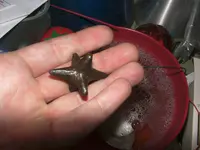Diggin'PA, first, please read the "About me" section of my Profile. The book is wrong. The object in the photo is variously known as a Mill-Star, Tumbler-Star, or Jack-Star, and is in actual fact tumbler-mill media. Ask yourself, as you see the object sitting in the photo, how could it pierce horse's hoof or a soldier's boot (or even, shoe-sole)? A caltrop MUST have a tertrahedral (four-pointed) form in order for it to sit on the ground with one of its spines always pointing STRAIGHT UP, to impale the foot of whoever steps on it.
Caltrop - Wikipedia, the free encyclopedia
The 6-pointed object found by Beeps In My Sleep and another in the book's photo won't sit with one point sticking straight up.
As I said in the previous TreasureNet discussion linked by SCDigginWithAK,
Caltrops that aren't caltrops .. Caltrops that aren't Jacks .. "Caltrops That Aren't"
the object in the photo is shown in an old Encyclopedia Of Metalcasting, but I lost the link to that Googlebook when my computer's hard-drive crashed beyond repair.
We also have the testimony of fellow TreasureNet member Fmerg, who used to work in a Metalfinishing workshop and said "I remember seeing some thing like these used in tumblers to knock off large pieces of slag when I worked in a machine shop. They were magnetic and used in a tumbler."
Also, the civil war relics website's photos at the link posted by Beeps In My Sleep of so-called "caltrops" for sale are SHINY-BRIGHT iron. Doesn't that raise any suspicion that they are not 150 years old? (You'll also see lots of the same thing for sale on Ebay in completely un-rusted condition.)
Why is the one Beeps In My Sleep found at a 250-year-old fort in shiny and COMPLETELY UN-PITTED condition? Even if he cleaned it by Electrolysis it ought to have at least SOME rust-pits from being in the ground for 200-250 years. Also, note that its points are too blunt to pierce shoe-leather or a horse's hoof. If they corroded down to bluntness, why doesn't the rest of the object show the same degree of rust-pitting?
Caltrops had to be used in quantities of hundreds or at least dozens to be effective. A reasonable-minded person would ask, why is it that hardly any of the tens-of-tousands of relic hunters in the US have ever dug even one of these 6-pointed objects, but hundreds are available in NON-EXCAVATED condition on Ebay and civil war relics websites? (Note that there are five of them for sale at the website linked by Beeps In My Sleep.)
The real problem comes down to this:
There is something in Human Nature which VERY much prefers to believe "I've found a rare and valuable historical relic" -- and no amount of contradictory evidence is enough to convince the finder that he is mistaken. I run into that problem every month with people who show me a rusty iron ball and want me to agree that it is a cannonball. It doesn't matter that the ball has a number 12 stamped in it, proving that it is a Sports Shot Put ball. It doesn't matter that its size doesn't correctly fit any caliber of historical cannon. By golly, it's ABSOLUTELY a rare and valuable cannonball, and it forever will be in the finder's mind.






 [h=2][/h]
[h=2][/h]

 ??
??